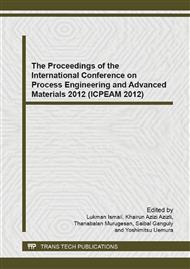[1]
Information on http: /www. eia. doe. gov/oiaf/1605/coefficients. html.
Google Scholar
[2]
Taherzadeh M.J. and Karimi K., Acid-based hydrolysis processes for ethanol from lignocellulosic materials: A review. Bioresources, 2(2007) 472-499.
Google Scholar
[3]
Hu G., Heitmann J.A. and Rojas O.J., Feedstock pretreatment strategies for producing ethanol from wood, bark, and forest residues. Bioresources., 3(2008) 270-294.
Google Scholar
[4]
Reese E.T., A microbiological process report: enzymatic hydrolysis of cellulose. Appl Microbiol, 4(1956): 39-45.
Google Scholar
[5]
Thomsen M.H., Thygesen A. and Thomsen A.B., Hydrothermal treatment of wheat straw at pilot plant scale using a three-step reactor system aiming at high hemicellulose recovery, high cellulose digestibility and low lignin hydrolysis. Bioresource Technol, 99 (2008).
DOI: 10.1016/j.biortech.2007.08.054
Google Scholar
[6]
Brethauer S. and Wyman C.E., Review: Continuous hydrolysis and fermentation for cellulosic ethanol production. Bioresource Technol, 101(2010) 4862-4874.
DOI: 10.1016/j.biortech.2009.11.009
Google Scholar
[7]
Petchpradab P., Yoshida T., Charinpanitkul T. and Matsumura Y., Hydrothermal pretreatment of rubber wood for the saccharification process. Ind. Eng. Chem. Res., 48(2009) 4587-4591.
DOI: 10.1021/ie801314h
Google Scholar
[8]
Kumar S. and Gummadi S.N., Metabolism of glucose and xylose as single and mixed feed in Debaryomyces nepalensis NCYC 3413: production of industrially important metabolites. Appl Microbiol Biot, 89(2011) 1405-1415.
DOI: 10.1007/s00253-010-2997-1
Google Scholar
[9]
Wyman C.E., Handbook of Bioethanol: Production and Utilization,. Taylor & Francis, Washington DC, (1996).
Google Scholar
[10]
Balat M., Production of bioethanol from lignocellulosic materials via the biochemical pathway: A review. Energ Convers Manage, 52(2011) 858-875.
DOI: 10.1016/j.enconman.2010.08.013
Google Scholar
[11]
Sabil K.M., Aziz M.A., Lal B., and Uemura Y., Effect of torrefaction on the physiochemical properties of oil palm empty fruit bunches, mesocarp fiber and kernel shell. Biomass Bioenergy, 56(2013) 351-360.
DOI: 10.1016/j.biombioe.2013.05.015
Google Scholar
[12]
Matsushika A. et al., Efficient bioethanol production by a recombinant flocculent saccharomyces cerevisiae strain with a genome-integrated NADP+ - Dependent xylitol dehydrogenase gene. Appl Environ Microb, 75(2009) 3818-3822.
DOI: 10.1128/aem.02636-08
Google Scholar


